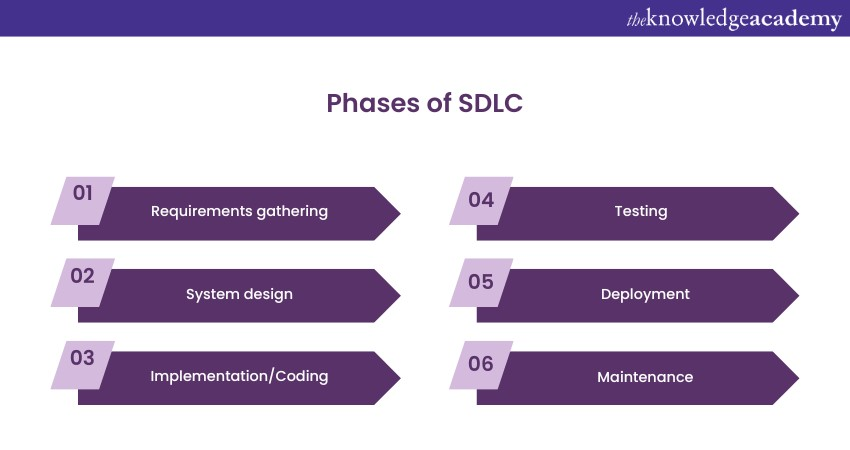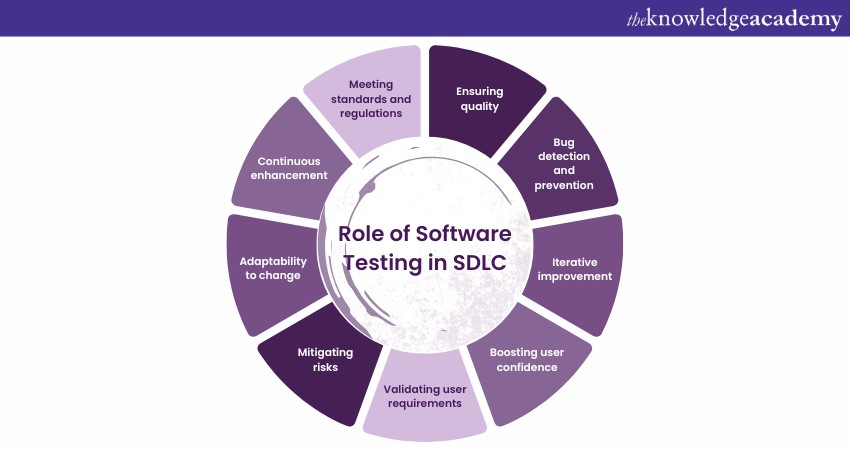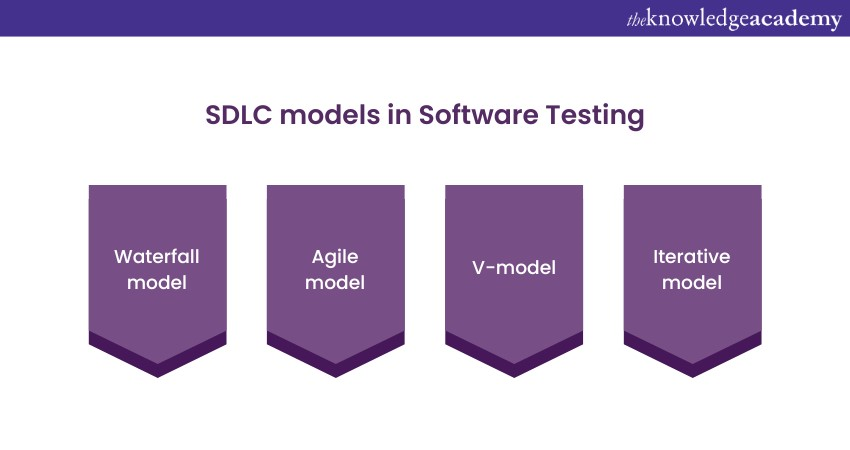We may not have the course you’re looking for. If you enquire or give us a call on 01344203999 and speak to our training experts, we may still be able to help with your training requirements.
Training Outcomes Within Your Budget!
We ensure quality, budget-alignment, and timely delivery by our expert instructors.

The Software Development Lifecycle (SDLC) is a process that guarantees the quality, cost-effectiveness, and efficiency of software. It is similar to a blueprint for creating software, just as a house requires a blueprint before construction. SDLC encompasses all stages of software development, from planning and design to testing and deployment. In this blog, we will explore what SDLC in Software Testing is all about and how it ensures that the software you develop is of high quality and functions exactly as you intended.
Table of Contents
1) What is SDLC in Software Testing?
2) Phases of SDLC
3) Role of Software Testing in SDLC
4) SDLC models in Software Testing
5) Benefits of Incorporating SDLC in Software Testing
6) Challenges and considerations
What is SDLC in Software Testing?
When we talk about creating software, it's like crafting a complex puzzle. To make sure all the pieces fit perfectly, we need a well-defined plan – and that's exactly what the SDLC provides. Think of it as a roadmap that guides us from the initial idea of the software to its final release and beyond.
Definition of SDLC
SDLC is a step-by-step process that Software Developers follow to design, build, test, deploy, and maintain software applications. It's like a series of stages that take us through the entire software development journey. SDLC guides developers in creating efficient and reliable software.
Importance of SDLC in Software Testing
Software Development Life Cycle holds significant importance in Software Testing. Here's why it matters:
a) Structured approach: SDLC provides a structured framework for software development, ensuring that testing is not a haphazard process but an organised sequence of stages.
b) Early bug detection: Incorporating testing throughout SDLC allows for the early detection of bugs and glitches, minimising the chances of critical issues surfacing during later phases.
c) Cost efficiency: Detecting and resolving bugs early is more cost-effective than dealing with them after the software is deployed. SDLC's testing integration saves time and resources.
d) Improved software quality: SDLC emphasises continuous testing, improving software quality, reliability, and user satisfaction.
e) Risk mitigation: By identifying potential issues early, SDLC-driven testing helps mitigate software failures and malfunctions risks.
f) Adaptability to change: SDLC facilitates iterative testing, making it easier to adapt to changing requirements, technologies, or user needs.
g) Predictable project progression: SDLC's defined phases offer predictability in project timelines and progress, aiding in efficient resource allocation and management.
h) Efficient communication: SDLC encourages clear communication between development and testing teams, reducing misunderstandings and delays.
i) Customer satisfaction: Rigorous testing within SDLC ensures that the final software meets or exceeds customer expectations, enhancing overall satisfaction.
j) Long-term reliability: SDLC's maintenance phase allows ongoing testing and updates, ensuring the software's continued reliability and functionality.
Phases of SDLC

SDLC consists of a series of interconnected phases that collectively guide the journey of software creation, from the initial idea to its deployment and maintenance. Each phase plays a distinct role in ensuring the development of functional, reliable, and user-friendly software applications.
Requirements gathering
The process starts by understanding the needs and expectations of stakeholders. This phase involves interactions with users, clients, and developers to gather a clear understanding of what the software should achieve. Properly documented requirements serve as a roadmap for the entire development process, ensuring that the end product aligns with user needs.
System design
Building on the requirements, the system design phase comes into play. Here, developers create a comprehensive architecture for the software. This design outlines how different components interact, ensuring a structured and efficient development process. The design phase is akin to creating a blueprint before constructing a building.
Implementation/Coding
Once the design is established, developers dive into the implementation phase. They write the actual code that brings the software to life. This phase translates the design and functional requirements into tangible code. It's like constructing a building's framework based on the architectural plans.
Testing
Rigorous testing is a cornerstone of SDLC. This phase systematically evaluates the software's functionality, performance, and security. Various testing types, such as unit, integration, system, and user acceptance testing, ensure the software operates as intended and identifies and rectifies any flaws or inconsistencies.
Deployment
After successful testing, the software is ready for deployment. It's installed on servers or devices accessible to users. This phase marks the transition from development to practical use. Similar to officially opening a new building, software deployment ensures users can start benefiting from its features.
Maintenance
The journey doesn't end with deployment; it continues with the maintenance phase. Here, developers monitor the software's performance, address issues, and make necessary updates. This ensures the software remains reliable, secure, and up-to-date, meeting user expectations over the long term.
Ready to elevate your testing skills? Join our Software Testing Green Belt Course for enhanced expertise and career advancement!
Role of Software Testing in SDLC
Software Testing plays a pivotal role within the Software Development Life Cycle, ensuring the creation of reliable, high-quality software applications. Let's understand its significance:

Ensuring quality
Software Testing is the quality assurance checkpoint of SDLC. It meticulously examines the software's functionality, performance, and security, ensuring it operates as intended and meets user expectations. Testing acts as a safety net, catching potential issues before they reach end-users.
Bug detection and prevention
Testing actively hunts for bugs and errors within the code. By identifying and addressing these issues early in the development process, testing prevents defects from escalating into critical problems that can emerge during deployment or post-release. This early detection reduces the cost and effort associated with bug fixing.
Iterative improvement
Testing operates iteratively, with feedback from each testing phase informing the subsequent development stages. This cyclical approach leads to continuous improvement, refining the software's quality and performance over time.
Validating user requirements
Software Testing ensures that the final product aligns with user requirements. It verifies whether the software functions according to the specified features and functionalities, meeting the intended purpose and addressing user needs.
Boosting user confidence
Thorough testing enhances user confidence in the software. A well-tested application is more likely to perform reliably, offering users a positive experience and minimising frustrations caused by unexpected errors or malfunctions.
Mitigating risks
Testing identifies and mitigates potential risks associated with software failures. By uncovering vulnerabilities and addressing them before deployment, testing contributes to a more secure and stable software environment.
Adaptability to change
Testing within SDLC ensures that the software can adapt to changes. Whether modifying functionalities or integrating new features, a robust testing strategy accommodates these changes while maintaining the software's integrity.
Continuous enhancement
Post-deployment testing remains crucial in the maintenance phase. Regular updates and patches are tested to ensure that they do not introduce new issues. This sustains the software's performance and security in an ever-evolving technological landscape.
Meeting standards and regulations
For industries with regulatory requirements, testing ensures that software adheres to specific standards and regulations. This is vital in sectors such as healthcare, finance, and aerospace.
Elevate your testing prowess to mastery – Join our Software Testing Black Belt Training and become a true expert in the art of quality assurance.
SDLC models in Software Testing
Software Development Life Cycle models show the sequence of phases in software development, and each model has a unique approach to development and testing. Let's explore some common SDLC models and understand how they influence the testing process:

Waterfall model
This traditional linear model follows a sequential approach. Each phase (requirements, design, development, testing, deployment) occurs linearly. While it provides a structured framework, testing primarily happens after development is complete, which can lead to delayed bug detection and higher costs for fixing issues.
Agile model
Agile emphasises flexibility and collaboration. Development occurs in short iterations called "sprints," with testing integrated throughout. This approach ensures that testing is continuous and adaptive, catching bugs early and allowing rapid adjustments based on user feedback.
V-model
The V-Model emphasises a strong relationship between the development and testing phases. It aligns each development stage with a corresponding testing phase. For instance, the design phase corresponds to design testing, and the coding phase to unit testing. This parallel approach ensures a more thorough testing process.
Iterative model
The iterative model involves repeated cycles of development and testing. Each cycle produces a functional version of the software, which is then refined in subsequent cycles. This model allows for incremental testing and continuous improvement, accommodating evolving requirements and enhancing software quality.
Impact on Testing:
a) Waterfall: Testing in the later stages might lead to delayed bug identification. Comprehensive testing is crucial to catch all issues before deployment.
b) Agile: Continuous testing ensures early bug detection and frequent validation of software functionalities. Testers collaborate closely with developers, improving communication and delivering a more robust product.
c) V-Model: The strong alignment between development and testing ensures that each phase is verified and validated. This minimises risks and increases the predictability of outcomes.
d) Iterative: Testing in each cycle helps maintain high software quality as issues are addressed incrementally. User feedback from each cycle informs testing improvements and enhances the software's usability.
Unlock the power of seamless software with our comprehensive Software Testing and Automation Training – equip yourself for the future of quality assurance!
Benefits and challenges of SDLC in Software Testing
Incorporating SDLC in testing improves quality, reduces costs, and enhances communication. Challenges include adapting to changes, balancing rigidity, and resource constraints.
Benefits of incorporating SDLC in Software Testing
Here is a list of benefits of incorporating SDLC in Software Testing:
a) Improved quality: Integrating SDLC in Software Testing ensures that testing is a continuous process throughout development. This leads to the early identification and rectification of defects, resulting in a higher-quality software product.
b) Reduced costs: Detecting and addressing issues early in the development process through SDLC-based testing significantly reduces the cost of fixing bugs post-deployment. This cost-effectiveness contributes to overall project savings.
c) Predictable project timelines: SDLC provides a structured framework that defines each phase's duration and sequence. This predictability aids in effective project planning, resource allocation, and meeting project milestones on time.
d) Efficient resource utilisation: SDLC-driven testing optimises resource allocation. Testing is performed systematically, allowing testers to focus on critical areas and allocate resources more efficiently.
e) Effective communication: SDLC encourages clear communication among cross-functional teams. Developers and testers collaborate throughout the development cycle, ensuring a shared understanding of project goals, requirements, and expectations.
Challenges of incorporating SDLC in Software Testing
Here is the list of Challenges of integrating SDLC in Software Testing:
a) Adapting to changing requirements: As requirements may evolve, adhering strictly to an SDLC model can be challenging. Flexibility is necessary to accommodate changing needs without compromising the integrity of the testing process.
b) Balancing rigidity and flexibility: Striking the right balance between following the defined SDLC model and adapting to unforeseen challenges is crucial. Being too rigid might hinder responsiveness to unexpected issues.
c) Communication between teams: Effective collaboration between development and testing teams is essential. Poor communication can lead to misunderstandings, inadequate testing, and delays in identifying and resolving issues.
d) Resource and time constraints: Implementing comprehensive testing within SDLC might require additional resources and time. Balancing testing efforts with project timelines and budget constraints is a continuous challenge.
e) Maintaining consistency: Consistency in testing practices across different phases and iterations can be demanding. Ensuring uniformity in testing methodologies and quality standards requires continuous effort and monitoring.
Unlock your potential in Software Testing with our comprehensive Software Testing Courses & Training programs - embark on a journey to become a skilled tester today!
Conclusion
The symbiotic relationship of SDLC in Software Testing empowers the creation of reliable, high-quality software. While benefiting from structured processes and improved collaboration, organisations must navigate challenges with flexibility, communication, and resource management to achieve successful software outcomes.
Frequently Asked Questions
Upcoming Programming & DevOps Resources Batches & Dates
Date
 Certified Software Testing Professional (CSTP)
Certified Software Testing Professional (CSTP)
Thu 1st Jan 1970







 Top Rated Course
Top Rated Course



 If you wish to make any changes to your course, please
If you wish to make any changes to your course, please


